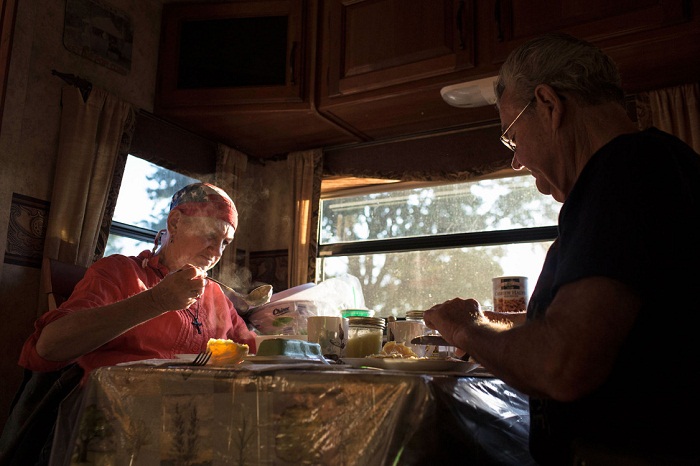It turns out this is an exercise in empathy. “We have an herb that stimulates the taste that cancer patients feel,” says Wagoner. “I give it to caregivers so that they can understand what the patient tastes.” Chemo mouth is a term used to describe the flavor changes that occur during chemotherapy. And suddenly, it makes more sense to me.

Gymnema sylvestre, an herb used to simulate the way that cancer treatment changes taste.
Living with cancer can make eating, especially eating healthy foods, less appealing. Even though proper nutrition plays an important role in healing, it is too often an afterthought for doctors, who focus on tests and treatments. How does one hospital network try to align these two sometimes competing challenges?
“Normally dietitians are [alerted] after a patient loses a certain amount of weight,” says Kalli Castille, director of nutrition and culinary services at CTCA in Tulsa. “We see patients the moment they walk in.”
Patient Lila Welch was first diagnosed with pseudomyxoma peritonei, a rare form of cancer, in 2011. When she began her treatment at CTCA, she says her eating habits totally changed. “I started eating right and eating the foods that would help me fight cancer: more protein, less sugar and bad carbs,” she says.
The focus on food at CTCA is, of course, to ensure that patients get the nutrients they need, but it’s also to equip people to cope with the changing palettes and dwindling appetites that can come with treatment.
Welch’s husband, Tom, is her main source of support (as well as her resident chef), and though her loss of appetite was an adjustment for him at first, he’s re-learned how to cook for her. These days he tempers his love for a “meat-and-potatoes” diet with vegetable soups, baked squash, and one-pot meals he crafts in his cast iron Dutch oven.
Wagoner explains that taste changes can be especially confusing for caregivers. “They’re used to making these meals they’ve made for 20 years, and the patients don’t like it anymore. The caregivers take it personally, but it’s not them,” he says. “We can solve a lot of spouse fights if we can get them the information,” he says.
Cooking for patrons who may not have an appetite is part of Wagoner’s job, so he tries to make foods that are visually appealing, emotionally comforting, and as nutritionally dense as possible. “You eat with your eyes,” he says.

Macaroni made with cauliflower hidden in the sauce.
“My theory is that when people are sick they want to go back to better times. You want the food that your mom used to cook you when you were sick,” he says. He works with Castille to modify comfort foods like macaroni and cheese so that they’re as appetizing as they are nutrient dense. “We put cauliflower in the cheese sauce, so they’re still getting a full serving of veggies in the food they crave,” he says. Even some of their desserts are laced with secret good-for-you foods like black beans in brownies and cauliflower icing. “You don’t know what you’re eating a lot,” Castille says, winking.
Castille explains that she’s working in a hierarchy of needs. The three main priorities for someone going through cancer treatment are fluid, calories, and protein. Once you satisfy those baseline needs, then you can become more picky about how you choose to meet them, she explains.
“If you’re in the midst of treatment and nothing sounds good but ice cream, it’s better to eat than not eat. What I don’t want is anyone feeling guilty.”
Because of this, you’ll see everything in the Tulsa CTCA cafe from cupcakes and potato chips, to a salad bar stocked with anti-inflammatory ingredients like blueberries and spinach, a spice rack featuring turmeric, cloves, and cinnamon, and a juice bar with recipes like the “keep it down” smoothie (branded as a pleasurable way to stomach the nausea combating properties of ginger). The cafe is covered in informational and inspirational signage. “Eat Every Color of the Rainbow Everyday!” flashes by on the TV in the dining area. It’s clear that their main goal is to be flexible and empower patients with information and healthy options.

An array of spices, which can be used to combat inflammation, nausea, and other ailments, are available at the salad bar in the cafe at Tulsa’s Cancer Treatment Center of America.
Wagoner usually posts up at a table in the cafe so he’s available to chat with diners during the day. He’s empathetic to the difficulties of cooking for a loved one who’s battling illness—his mom is a cancer survivor. When she asked what she should eat after her diagnosis, he says she was told to “eat what you have been eating, but do it in moderation,” where she was receiving treatment. “We like to think that we do more than that,” he says.
Wagoner’s best tip for caregivers? Figure out at least five dishes that the person you’re cooking for enjoys and have those ingredients on hand.
The focus on healthy eating seems to be catching on. This CTCA makes lunches for two area schools, and I’m told that a former patient still dines at the center’s cafe every day. It’s a rare cafeteria where you can easily eat for a gluten-free or low-sodium diet, find hidden veggies in decadent food, eat every color of the rainbow, every day, and still enjoy it.
















































